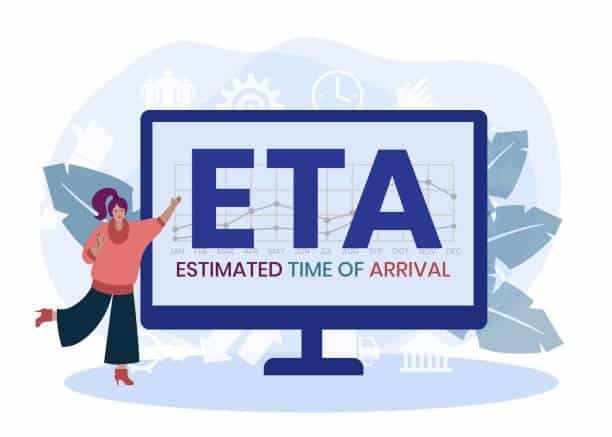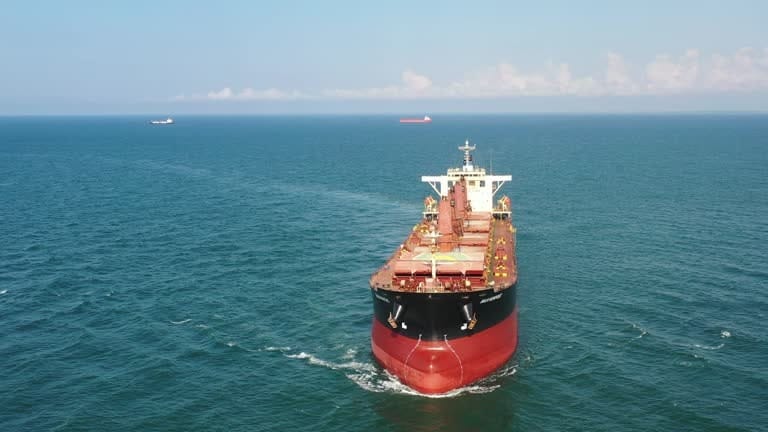The process of computing Estimated Time of Arrival stands fundamental across logistics and transportation, project management and navigation. The projection tool enables companies and people and institutions to forecast the duration of specific activities along with delivery times of ships to their destinations. Awareness of ETA computation techniques is vital in today’s environment where efficient time-driven operations remain crucial to successful planning and resource management and schedule optimization. The following piece analyzes ETA by examining what makes it important along with various calculation approaches and elements that affect its precision levels.
Understanding ETA and Its Importance

The introductory phase explains ETA fundamentals and their significance as background information for exploring calculation methods. One defines ETA as the predicted average time take for anything to reach its designated destination. The principle finds wide application throughout transportation and shipping along with software development to handle time-dependent delivery management and sequence management.
Businesses that deliver goods must determine trip ETA precisely to maintain customer contentment levels. Customers demand immediate notifications about package delivery times yet delays cause both unhappy customers and business losses. The precise calculation of estimated time of arrival significantly influences flight and shipping operations since it enables businesses to perform subsequent ground handling and customs checks and arrange onward connections.
The Estimate to Completion function serves as a/project management tool for predicting the completion time of projected tasks/milestones. A project manager’s accuracy in ETA forecasting enhances resource allocation and risk reduction while maintaining deadline fidelity. ETA ensures teams maintain clear communication and lets them establish performance expectations and track scheduled timeline completion arrival calculator.
Key Factors That Influence ETA Calculation

The procedure for computing ETA presents multiple challenges. Different elements need evaluation to achieve maximum accuracy from estimates. The elements used for duration assessment differ according to specific business sectors and operational settings.
- Distance: Distance between starting location and destination marks one of the essential inputs for computing Estimated Time of Arrival. GPS and planning depend on establishing baseline timeframes owing to distance measurements between origins and destinations.
- Speed: The calculation of ETA relies determinatively on speed measurements. Time to completion and object movement speed directly influence when an Estimated Time of Arrival (ETA) will become due. Various underlying factors shape speed including equipment type and vehicle selection as well as environmental conditions and worker performance.
- Traffic Conditions: To calculate ETA in transportation operations traffic remains one of the major elements that substantially impacts estimated delivery periods. The combination of traffic backups due to congestion and road construction events and vehicle accidents and daily travel times creates delays in estimated travel periods. Real-time traffic data integrated into ETA predictions is now standard practice throughout numerous transportation sectors with particular emphasis on delivery services.
- Weather: Travel operations can experience delays and their estimated arrival time will greatly change when adverse weather conditions such as heavy rainfall or snow combine with fog conditions. Forcing unpredictable situations impair our ability to compute precise journey duration estimates. Weather data together with ETA computation helps organizations prevent additional delays caused by unexpected events.
- Route Optimization: Route selection exercises direct influence on the expected travel duration. Travel time to destination shortens when mapping out quicker ways yet extended or difficult routing can make the estimated time to arrive drag on. GPS technology couples with route optimization software to pick the best route possible according to live data records and current road conditions.
- Work Efficiency and Task Complexity: Project positioners use task complexity to determine Estimated Time of Arrival (ETA) within software production and project administration environments. Simple tasks tend to complete rapidly alongside their ETA but complex projects extend ETA due to planning time along with execution periods and review requirements. Job duration varies according to three main factors which include worker performance along with available resources and tasks that depend on others.
- Unexpected Delays: ETA can sustain changes due to unexpected obstacles including mechanical failure of equipment or worker unavailability or machine malfunctions. Contingency plans should exist for unpredictable events even though these events lie beyond personal control so ETA adjustments reflect current circumstances.
Avoiding Traffic to Optimize the ETA

Estimates of arrival times are frequently interrupted by traffic congestion which causes delays throughout delivery services appointments and travel plans. Multiple strategies partnered with technological solutions help businesses optimize ETA while reducing traffic delays. The combination of smart routing and real-time traffic data and predictive analytics together with alternative transportation methods enables users and businesses to reduce delays for timely arrivals eta calculator.
1. Utilizing Real-Time Traffic Data
Real-time traffic data represents one of the most powerful tools for both traffic prevention and ETA optimization. Several navigation applications including Google Maps, Waze and Apple Maps along with vehicle GPS systems retrieve road sensor data together with governmental traffic reports and end-user inputs to deliver consistent real-time road status information.
- Live Traffic Monitoring: Real-time traffic systems involve roadblock detection along with accident and congestion reporting that helps drivers pick low-traffic routes.
- Dynamic Rerouting: From the moment traffic congestion develops navigation systems automatically reevaluate ETA followed by suggestions for alternative routes.
- Incident Reports: Users can utilize specific applications to file road incident reports for accidents, construction areas and blocked roads so actual traffic data can be updated effectively.
2. Choosing Optimal Travel Times
Traffic congestion exhibits distinct patterns according to daily timeframes and weekly schedules in addition to special community occasions. Using travel times outside normal peak periods saves commuting time while boosting estimated arrival predictions.
- Avoid Rush Hours: Weekday travel peaks from 7:00 AM to 9:30 AM and continues through 4:30 PM to 7:00 PM. When you schedule journeys to depart and arrive between the rush hour periods you will encounter minimal delays during your commute.
- Weekend vs. Weekday Traffic: Different locations exhibit varying traffic levels on weekends because local residents perform shopping tasks plus engage in leisure activities and attend local events. Local traffic patterns help people plan their travel better.
- Late-Night or Early-Morning Travel: Travel during late-night before daytime commences and during early morning hours allows drivers to make better use of available road capacity resulting in shorter trip durations.
3. Using Alternative Routes and Backroads
Better ETA times can be achieved by drivers who move away from major thoroughfares and select minor streets combined with less busy detours.
- Avoiding High-Traffic Zones: Downtown business districts together with shopping centers maintain high traffic density levels during select time slots. The change of travel from high-traffic regions leads to better travel time.
- Using Toll Roads: Toll roads although more expensive than free highways serve as practical tools for speeding up travel because they remain less congested.
- Shortcut Identification: During heavy traffic periods the quickest travel paths often come from alternative unorthodox routes instead of main streets or highways. Shortcuts available for discovery with the help of navigation applications.

4. Leveraging AI and Predictive Analytics
AI-enabled predictive analytics and artificial intelligence applications help ETA optimization lead to better forecasting through examination of past traffic patterns.
- AI-Powered Navigation: AI algorithms use multiple historical traffic behavior datasets to identify the best route which will steer clear of traffic delays with optimal precision.
- Machine Learning Models: Google Maps’ predictive traffic system analyzes historical data through machine learning models to predict traffic changes over time.
- Weather-Based Adjustments: AI technology analyzes weather patterns to forecast how road conditions will affect traffic therefore drivers can choose alternate routes before potential congestion occurs.
5. Utilizing Public Transportation or Alternative Mobility Options
When public transportation systems or bicycle services and ridesharing options replace personal vehicle usage it leads to better ETA outcomes and dwell time along with reduced traffic holdups.
- Public Transit Lanes: Several municipal areas allocate distinct bus and train corridors through which their public transit systems travel unimpeded by street traffic.
- Bike and Scooter Sharing Services: Travel time with bicycles and e-scooters as well as other micromobility options is faster than commuting by car through congested areas.
- Carpooling and HOV Lanes: The purpose of high-occupancy vehicle lanes is to serve commuters with multiple occupants and provides substantial travel benefits.
6. Planning Routes Based on Road Conditions and Construction Updates
Travelers experience extended delays because of construction sites accompanied by temporary road blockades and ongoing infrastructure maintenance activities. People who wish to optimize their forecasted time of arrival should use road updates as information before starting their journey.
- Government Traffic Websites: Official real-time construction updates can be accessed through state and city transportation department web portals.
- Navigation Alerts: Navigation programs show work zones alongside routes they recommend forURES when encountering construction areas.
- Seasonal Road Closures: Travelers need to incorporate seasonal road closures into their plans when they plan journeys to areas with unusually harsh winter conditions.
7. Implementing Fleet and Logistics Management for Businesses

The optimization of expected time of arrival requires businesses with delivery service that needs to create improved logistics strategies as well as establish detailed route planning approaches.
- Fleet Tracking Systems: Actionable route modifications stem from GPS-based fleet tracking systems which track transportation vehicles as they move.
- Traffic-Aware Dispatching: Real-time traffic information processing within delivery dispatch systems enables logistics organizations to strategically manage their truck driver routes.
- Load Balancing: A system strategy which splits deliveries among various vehicles while reorganizing routes according to traffic congestion helps businesses operate more efficiently.
Methods to Compute ETA
This section details the different computational approaches to determine ETA after our exploration of the important influencing factors. Different industries and applications may require different approaches to gather data for calculating ETA, but the core principle remains the same: Events receive time predictions through analysis of existing information.
1. Simple ETA Calculation Formula
Most situations enable simple computation of estimated time of arrival. A basic formula for calculated ETA is:
ETA=DistanceSpeed+Starting Time
ETA=
Speed
Distance
+Starting Time
The calculation uses a model where mobility remains stable during transit and excludes secondary environmental elements that could impact arrival time. The equation finds applications starting from driving navigation systems to repeating task duration estimations.
For example, if a vehicle is traveling 150 miles at a speed of 60 miles per hour, the ETA would be:
ETA=15060+0=2.5 hours
ETA=
60
150
+0=2.5hours
The calculation offers a simple prediction method, which disregards changes in driving parameters along with environmental factors such as weather or traffic conditions.
2. Real-Time Traffic-Based ETA
The combination of real-time traffic data with calculation systems enhances transportation and logistical ETA accuracy. Algorithms operating inside Google Maps and Waze software use present-day traffic information to calculate estimated time and deliver more reliable arrival-time forecasts. These platforms adapts ETA predictions through live adjustments according to factors including congestion and accidents and road closure incidents.
Travel times for normal two-hour trips experience a thirty-minute delay because of traffic congestion. A software system modifies the estimated time of arrival to represent the same size as predicted actual execution time therefore providing improved predictive forecasts to both drivers and dispatchers.

3. Route Optimization ETA
Logistics companies enhance their ETA by running route optimization algorithms which find the fastest route configurations based on current data. Navigation software recommends optimal routes created by analyzing both roadway characteristics and vehicle capabilities with vehicle specifications and traffic data along with distance considerations.
Such technologies help goods delivery businesses meet crucial delivery time frames expected by their customers. Route optimization algorithms will direct multiple drivers of a delivery truck to bypass traffic congestion which leads to shortened delivery times while the truck moves further from its shortest distance path.
4. Predictive ETA Using Machine Learning
Machine learning algorithms employ prediction methods that extract ETA from records of past travel patterns. These statistical models process historical travel records to find consistent patterns including typical durations for navigating between specific routes during particular daily periods. A predictive ETA system uses data from historical records along with expert mathematical models to handle scenarios that human navigation teams would struggle to anticipate regarding traffic disruptions and weather patterns or surface hazards.
The combination of historical performance and weather data and additional variables enables industries in aviation and maritime shipping to forecast delivery times using predictive ETA systems. By using this tactic organizations maximize their operational performance which enables them to enhance their schedule optimization alongside resource management.
Challenges in Computing ETA

The process of ETA prediction appears straightforward but unexpected obstacles frequently create precision difficulties. Weather conditions together with traffic patterns as well as changes in route conditions serve as uncontrollable variables that adjust the predicted time of arrival. The key challenges in computing ETA include:
- Data Accuracy: Reliable data elements play an essential role in computing accurate ETA predictions. when using poor-quality or outdated data systems it becomes common to generate incorrect predictions that could result in system inefficiencies or delivery delays.
- Dynamic Factors: Real-time situations including traffic changes and accidents with weather conditions produce unpredictable effects on estimated travel time predictions. An accurate prediction of travel duration needs dynamic processes which track and respond to real-time changes.
- Complex Systems: Management of ETA calculations remains complex because many variables matter in fields such as logistics and aviation and shipping industries. Sophisticated technology along with advanced algorithms are necessary to handle these systems.
- Human Error: Human errors related to time predictions and data interpretation sometimes impact the precision of Estimated Time of Arrivals calculations. Fully accurate predictions depend upon automatic systems working in tandem with human evaluation.
Conclusion
ETA computation delivers vital functionality which industry sectors across logistics and transportation along with project management utilize daily. Organizations and individuals can better estimate event timelines through careful analysis of total distance, together with speed alongside traffic conditions and weather and lane optimization. GPS systems and predictive analytics together with machine learning algorithms from technology advancements deliver substantial improvements in ETA estimation precision. The achievement of reliable predictions requires continuous supervision over real-time data accuracy along with dynamic variables management processes.
Accurate ETA scheduling represents an essential mechanism that must always prove essential to industries which demand swift delivery capability along with firm schedule compliance. The combination of appropriate software tools and an observation of important variables enables businesses to achieve client fulfillment and resource peak efficiency while decreasing delivery times. To support delivery services and maintain safety standards everyone must stay clear of heavy traffic zones for better estimated time of arrival predictions. Real-time traffic data and navigation systems under AI guidance with alternative travel paths along with automated scheduling help minimize delays during transportation. The adoption of predictive analytics and fleet management technology systems enables accurate ETA prediction which results in optimized operational efficiency.




